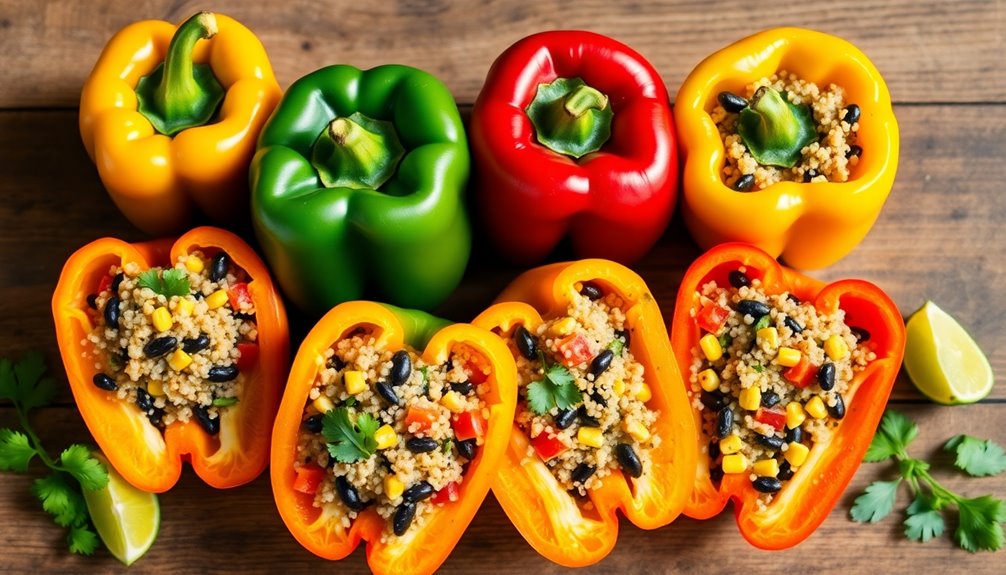Veggie-stuffed bell peppers are a colorful way to boost your nutrition while tantalizing your taste buds. By mixing in hearty grains like quinoa or brown rice with protein-rich black beans and a mix of fresh vegetables, you create a dish that's both satisfying and healthy. Choose peppers in bright reds, yellows, and greens for a stunning presentation and unique flavors. You can roast, grill, or sauté them for varied textures and tastes. Top it off with seasonings like cumin or paprika for extra flair. If you're intrigued by different variations and serving ideas, there's plenty more to explore!
Key Takeaways
- Choose colorful bell peppers for unique flavors and visual appeal in your veggie-stuffed dish.
- Fill with nutrient-dense ingredients like quinoa, beans, and assorted vegetables for a balanced meal.
- Experiment with different cooking methods such as roasting or grilling to enhance flavors and textures.
- Store leftovers by wrapping tightly and freezing, ensuring moisture retention during reheating for optimal taste.
- Serve on a rustic board with garnishes to create an inviting atmosphere for sharing and conversation.
Benefits of Veggie-Stuffed Peppers
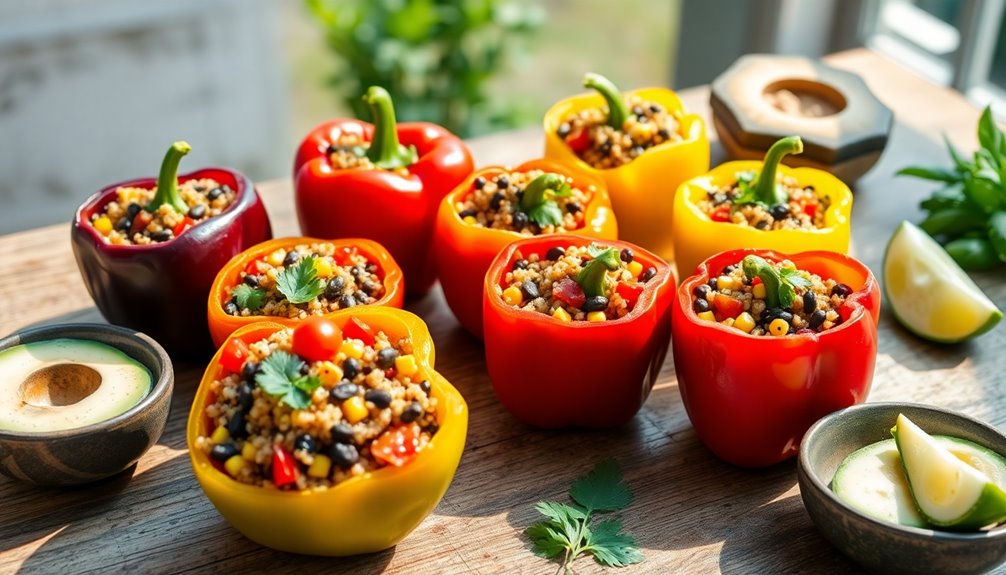
Veggie-stuffed bell peppers offer a delicious way to boost your nutrition while enjoying a colorful and satisfying meal. These vibrant vegetables not only catch the eye but also pack a punch when it comes to health benefits. When you fill them with a mix of grains, beans, and your favorite veggies, you create a versatile dish that accommodates various dietary preferences.
Whether you're vegan, vegetarian, or just looking to add more plant-based meals to your routine, these peppers can easily adapt to your needs.
One major health benefit is the high vitamin and mineral content. Bell peppers are rich in vitamins A and C, which support eye health and enhance your immune system. When you combine them with nutrient-dense fillings like quinoa or brown rice, you're not just satisfying your hunger; you're fueling your body with essential nutrients.
Furthermore, the fiber from the vegetables and grains keeps you feeling full longer, making it easier to maintain a healthy weight. You can even get creative with spices and herbs, enhancing the flavor without adding extra calories.
Gathering with friends or family to share these colorful peppers can create a sense of belonging, as everyone can customize their own. From spicy to savory, the options are endless.
Choosing the Right Bell Peppers
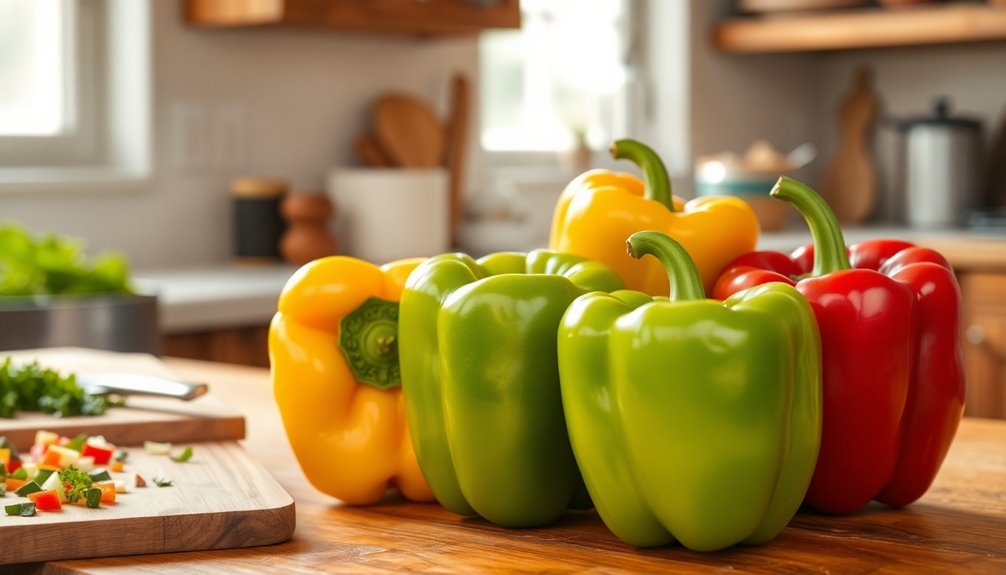
When it comes to making veggie-stuffed bell peppers, selecting the right peppers is key to achieving that perfect balance of flavor and texture. You'll find bell peppers in a rainbow of colors—red, yellow, green, and orange—each bringing its unique flavor profile to your dish.
Red bell peppers are sweet and juicy, making them a favorite for those who enjoy a little sweetness in their meals. They're ideal if you want your stuffed peppers to have a rich, slightly caramelized taste.
Yellow and orange peppers offer a milder sweetness; their vibrant colors can brighten up your dish, adding visual appeal as well as flavor.
Green bell peppers are the least sweet, with a slightly bitter and herbaceous taste. If you prefer a more savory note, they're an excellent choice. Mixing a variety of bell pepper colors not only enhances the visual presentation but also creates a delightful complexity in flavor.
When choosing your peppers, look for ones that feel firm and heavy for their size, with smooth, unblemished skin. Avoid any that show signs of wrinkling or soft spots, as these can indicate age or spoilage.
Essential Ingredients
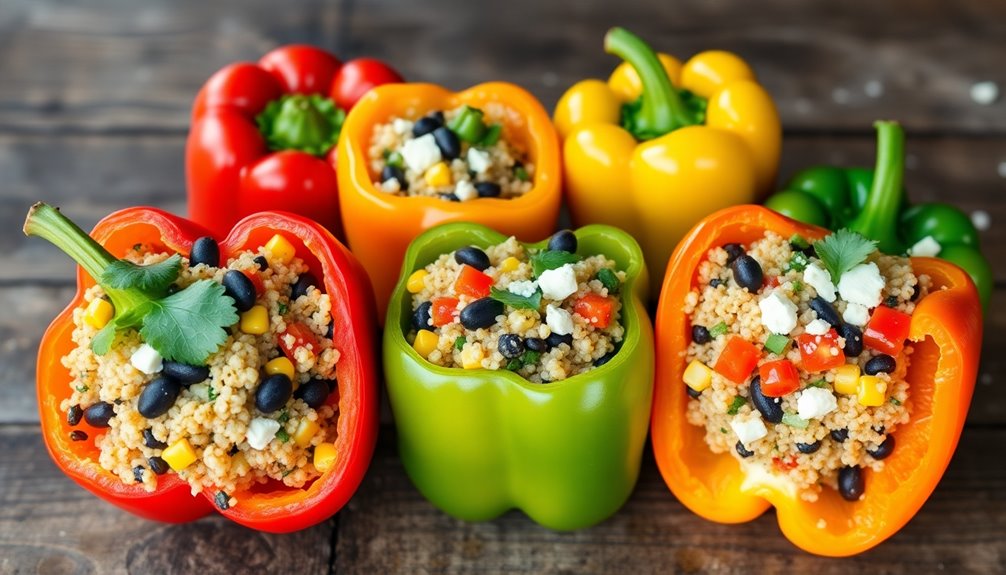
To create delicious veggie-stuffed bell peppers, you'll need a handful of essential ingredients that bring flavor and nutrition to the dish. These ingredients not only enhance the taste but also offer a colorful contrast that makes your meal visually appealing. Think about the vibrant hues of red, yellow, and green bell peppers, which can elevate your dining experience. Here's a quick list of what you should gather:
- Grains: Quinoa, brown rice, or couscous for a hearty base.
- Beans: Black beans or chickpeas add protein and nutritional value.
- Veggies: Onions, tomatoes, and zucchini for added texture and flavor.
When you're selecting your ingredients, remember that ingredient substitutions are totally fine. If you're out of quinoa, brown rice works just as well! Want to add a bit of spice? Experiment with seasoning options like cumin, paprika, or even some fresh herbs to elevate your dish further.
This flexibility allows you to tailor the recipe to your taste preferences and dietary needs while still achieving that comforting, home-cooked feel. Plus, knowing you're incorporating diverse ingredients means you're not just making a meal; you're creating a nourishing experience for yourself and anyone sharing the table with you.
Preparation Steps
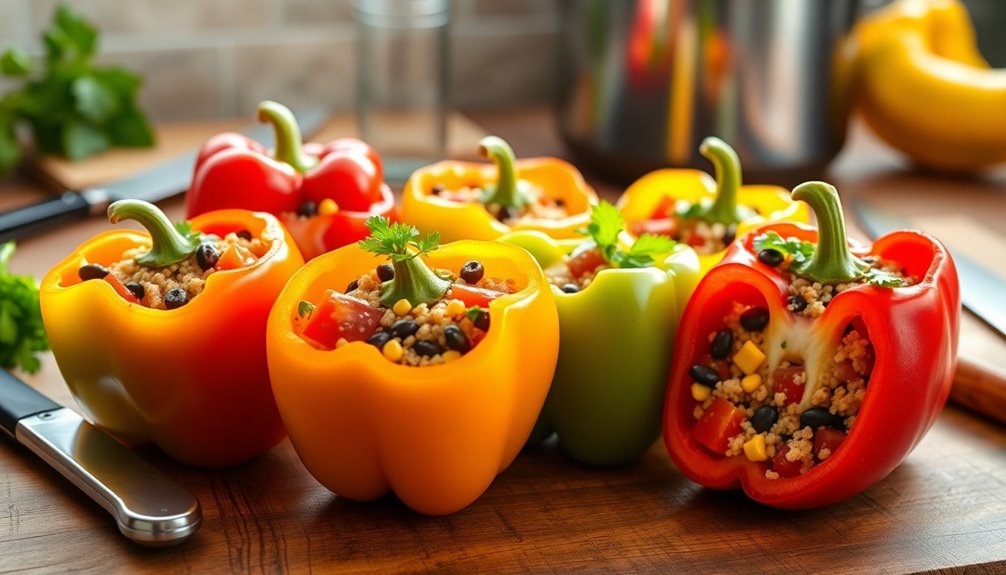
Now that you've gathered all your vibrant ingredients, it's time to bring everything together in the kitchen. Start by preheating your oven to 375°F (190°C). While that warms up, grab your trusty knife and cutting board.
Slice the tops off your bell peppers and carefully remove the seeds and membranes. Keep those tops; they can add a charming touch to your dish later!
Next, let's prepare the filling. In a large mixing bowl, combine your chopped vegetables, grains, or beans of choice. This is where you can let your creativity shine! Think about unique combinations—maybe quinoa with black beans, corn, and diced tomatoes, or brown rice mixed with sautéed mushrooms and spinach. Don't forget to add spices and herbs; they'll elevate your dish.
For some time-saving tips, consider chopping your vegetables in advance or using pre-packaged options. You can also cook your grains ahead of time to make assembly a breeze. Once your filling is ready, spoon it generously into each bell pepper, packing it in tightly.
As you fill each pepper, think about how each one can be a canvas for your culinary imagination. Place the filled peppers upright in a baking dish, and if you saved those tops, nestle them back on for a whimsical touch. Cover the dish with foil to keep everything moist, and you're now ready to move on to the next step! Your veggie-stuffed bell peppers are on their way to becoming a delicious reality.
Cooking Methods
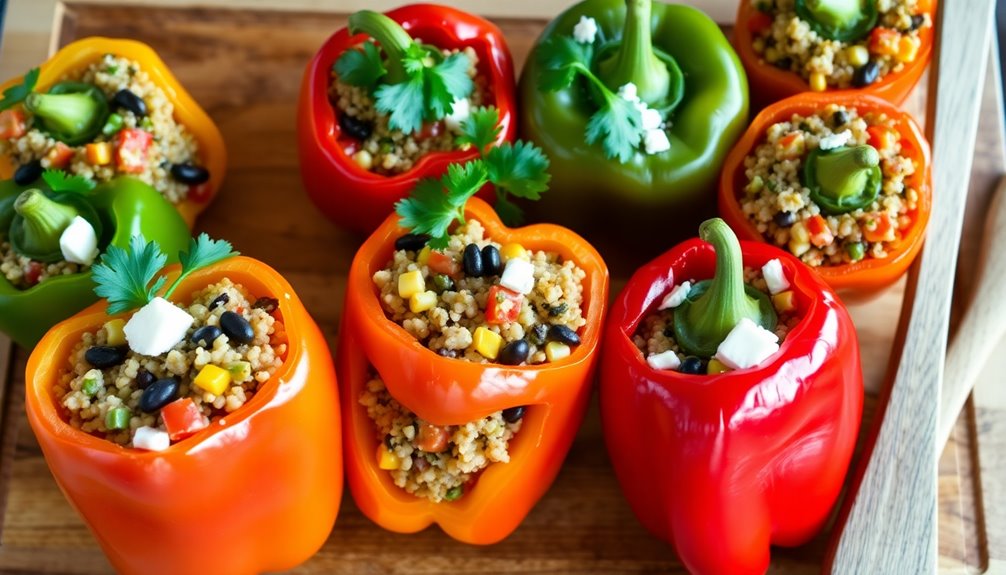
Cooking your veggie-stuffed bell peppers can be a delightful experience, and you've got a few methods to choose from, each offering unique flavors and textures. Whether you're in the mood for something smoky, caramelized, or quick and easy, the right cooking method can elevate your dish to new heights.
Here are a few popular methods:
- Roasting: This method brings out the natural sweetness of the peppers and filling. Simply place your stuffed peppers in the oven at around 375°F (190°C) for about 30-40 minutes. The result? Tender, flavorful bites with a slightly charred finish that are hard to resist.
- Grilling: If you're looking for that smoky flavor, grilling is your go-to. Preheat your grill and cook the peppers for about 15-20 minutes, turning occasionally. This method adds a fantastic char and is perfect for summer gatherings with friends and family.
- Sautéing: For a quick and versatile option, sautéing is ideal. You can prepare your filling on the stovetop using sautéing techniques, then stuff it into the peppers and bake for just 10-15 minutes. This method is perfect if you're short on time but still want a delicious meal.
Whichever method you choose, you'll create a dish that not only nourishes the body but also warms the heart. So grab your ingredients, and let's get cooking!
Flavor Variations
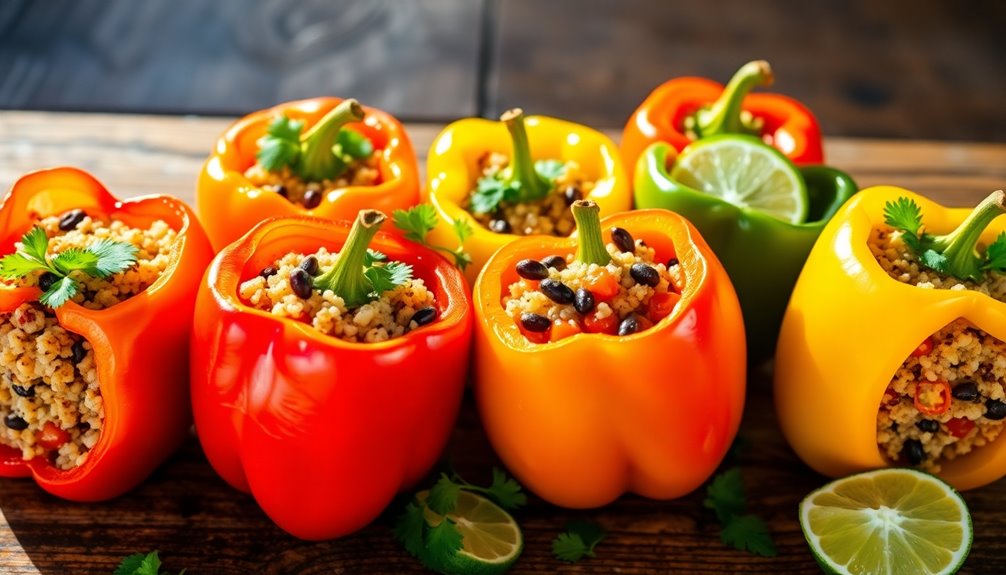
Exploring flavor variations for your veggie-stuffed bell peppers opens up a world of culinary creativity. You can easily transform this dish into something extraordinary by experimenting with unique combinations and embracing seasonal variations. Think about what ingredients you love and what's fresh and available.
Here's a table to inspire your next flavor adventure:
| Season | Flavor Profile | Unique Combinations |
|---|---|---|
| Spring | Bright and Zesty | Lemon zest, asparagus, feta |
| Summer | Fresh and Sweet | Corn, black beans, cilantro |
| Autumn | Warm and Earthy | Squash, sage, walnuts |
| Winter | Hearty and Comforting | Kale, quinoa, smoked paprika |
As you explore these combinations, consider the textures and colors that will make your dish visually appealing. For instance, in the summer, the sweetness of corn and the freshness of cilantro can create a delightful contrast to the bell pepper's crunch. In autumn, the earthy flavor of squash paired with crunchy walnuts can bring warmth to your table, making it perfect for gatherings.
Don't hesitate to mix and match ingredients based on what's in your pantry or what's calling your name at the market. These flavor variations not only enhance the dish but also create a sense of belonging as you share your creations with friends and family. Your veggie-stuffed bell peppers can reflect the seasons and your culinary personality, making every bite a celebration!
Serving Suggestions
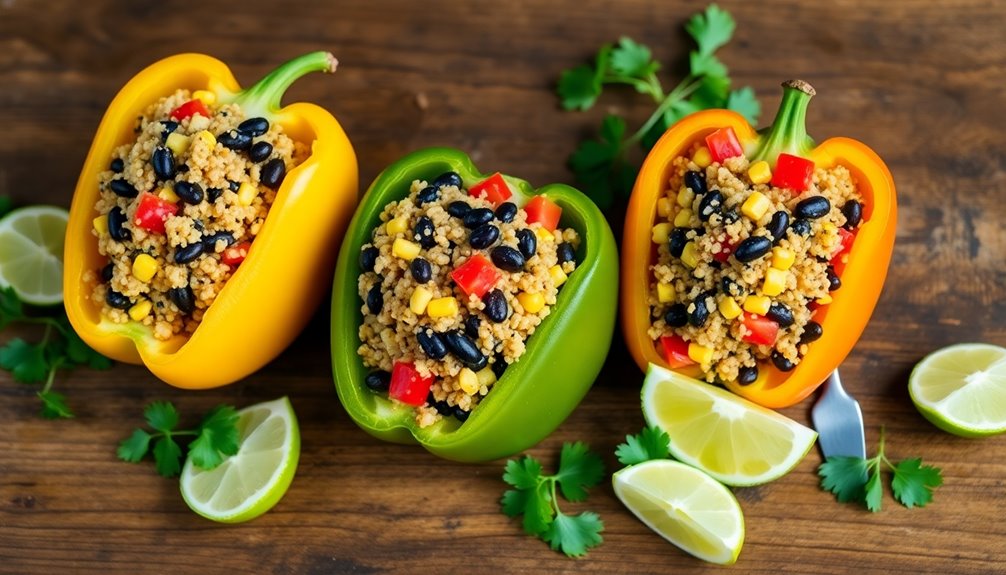
After you've prepared your delicious veggie-filled bell peppers with unique flavor variations, it's time to think about how to present and serve them for maximum impact. A well-presented dish elevates your meal and makes everyone feel special. Here are some presentation tips to help you shine:
- Color Contrast: Use brightly colored bell peppers to enhance the visual appeal. Pair them with a vibrant side salad or roasted vegetables to create a feast for the eyes.
- Garnish Options: Fresh herbs like cilantro, parsley, or basil can elevate your dish. A sprinkle of feta cheese or a drizzle of balsamic glaze adds a gourmet touch that invites admiration.
- Creative Pairings: Serve your stuffed peppers alongside quinoa, couscous, or a light tomato sauce for a balanced meal. You could also offer a invigorating yogurt sauce or homemade salsa for an extra layer of flavor.
When you serve your veggie-filled bell peppers, consider arranging them on a rustic wooden board or a colorful platter. This not only looks inviting but also encourages sharing and conversation. Your guests will appreciate the effort you put into making the meal special, and it'll create a warm, welcoming atmosphere.
Storing Leftovers
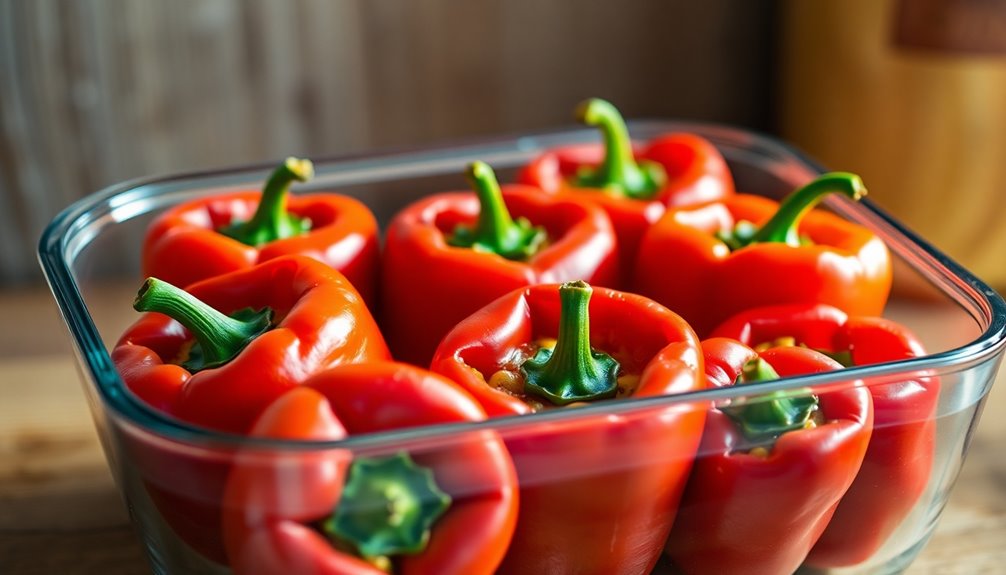
Maximizing the freshness of your veggie-stuffed bell peppers is easy with proper storage techniques. To keep those vibrant flavors intact, start by letting your leftovers cool to room temperature. Once cooled, you'll want to wrap each pepper tightly in plastic wrap or place them in an airtight container. This prevents moisture loss and keeps your peppers from drying out.
If you're not planning to eat them within a few days, consider freezing them! For freezing, here are some handy freezing tips:
- First, wrap each stuffed pepper individually in aluminum foil for added protection against freezer burn.
- Then, place them in a freezer-safe bag or container, labeling it with the date. This way, you'll enjoy them at their best for up to three months.
When you're ready to indulge in those tasty leftovers, follow these reheating instructions:
- If frozen, it's best to thaw your peppers in the fridge overnight.
- For reheating, preheat your oven to 375°F (190°C) and place the peppers in a baking dish, covered with foil to retain moisture.
- Heat for about 20-25 minutes or until they're warmed through.
- You can also pop them in the microwave for a quicker option—just be sure to cover them to keep steam in!
Frequently Asked Questions
Can I Freeze Veggie-Stuffed Bell Peppers for Later Use?
Yes, you can freeze your veggie-packed dish for later use! To guarantee they taste great, follow some freezing tips:
- Let them cool completely before wrapping them tightly in plastic wrap or aluminum foil.
- For reheating options, simply thaw them in the fridge overnight, then bake or microwave until heated through.
This way, you'll savor that delicious flavor whenever you want, making mealtime feel special and satisfying, even on busy days.
Are There Any Common Allergens in Veggie-Stuffed Bell Peppers?
Common allergens can sneak into your meals like ninjas! When you're considering allergen considerations, think about ingredients like nuts, soy, or dairy that might be hiding in recipes.
If you have dietary restrictions, you've got plenty of substitution options! With the right flavor profiles, you can create delicious dishes that cater to everyone.
Embrace creativity in the kitchen, and you'll guarantee no one feels left out at the table!
How Can I Make Veggie-Stuffed Peppers Spicier?
If you wanna kick up the heat in your dish, try adding jalapenos or a splash of sriracha for that extra zing.
Using spicy salsa or a few dashes of hot sauce can also elevate the flavor profile, giving your meal a delightful kick.
Don't be shy—experiment with different levels of spice until you find the perfect balance. You'll impress your friends and family with a dish that's bursting with flavor!
What Are Some Suitable Side Dishes to Pair With Bell Peppers?
When you're thinking about side dishes to pair with bell peppers, consider roasted potatoes for their crispy texture and savory flavor. They complement the bell peppers beautifully.
Garlic green beans are another excellent choice; their bright, fresh taste balances the sweetness of the peppers. Together, these sides create a colorful, satisfying plate that invites everyone to gather around the table and enjoy a delicious meal.
You'll feel right at home with these delightful combinations!
Can I Use Other Vegetables Besides Bell Peppers for Stuffing?
Absolutely, you can use different vegetables for stuffing! Think about zucchini, mushrooms, or even eggplant as alternative stuffing options. Each vegetable brings its unique flavor and texture, making your dish exciting and versatile.
You can fill them with grains, cheeses, or a mix of spices to create a delightful meal. Don't hesitate to experiment with what's in your fridge; it's a great way to make your cooking feel fresh and inclusive!
Conclusion
So, there you have it—veggie-stuffed bell peppers, the culinary equivalent of a cozy sweater for your stomach. Who knew those colorful capsules could hold a treasure trove of nutrients? As you set off on this tasty journey, remember: each bite is a hug for your taste buds, and leftovers? They'll sit in the fridge like a forgotten novel, waiting for the day you finally decide to give them a second chance. Bon appétit, you gourmet gardener!

